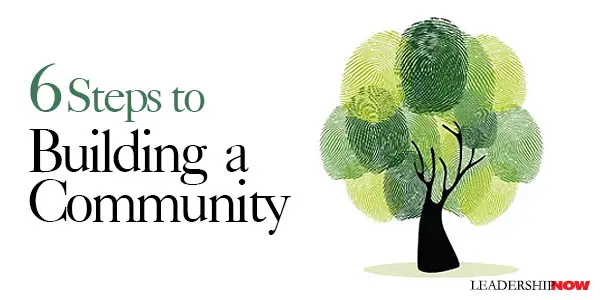
6 Steps to Building a Community

I
N BUSINESS AND IN LIFE, it’s all about relationships. We are designed to connect with others. When we are connected to something larger than ourselves, we find meaning. We make a difference.
Organizational health is facilitated by building community within your organization. It’s not easy, and it can’t be forced. Community is a
long-term solution to engagement, commitment, and talent retention. In
The Power of Community, Howard Partridge has broken down the process of building a community within your organization into
three keys with six action steps.
Support
The first key to building community in your business is supporting your team members. “Many employees feel no one care about them. What if you started helping your team members reach their goals in life? This is a major key to the whole idea of community. In order to get support, we have to give support.” So this is where you begin:
1. Value True Community
Make community your top priority. You can’t build it if you don’t value it. You begin by asking these on your team about their personal goals and dreams. Then begin to help them with that or connect them with people who can. It’s about “care and coach” rather than “command and control.” Find someone to support.
2. Pursue Champion Connection
Place a high value on your team. They should not be treated as a resource but as friends. If you support them, they will support you. “Pursuing champion connections means investing intentionally in relationships that have the potential to become strong alliances of support and mission. On the inside of your organization, you’ll want to begin by selecting a couple of people on your leadership team who you know are loyal to you. Begin intentionally investing in those relationships, and then you can expand the size of the group from there.” Do this on the outside of your organization too. Identify people who have the same values as you but also people who have different gifts than you.
Encouragement
The second key to building community in your business is encouragement. “Encouragement is what inspires people to do the things they don’t feel like doing, the things they fear doing, and the things they don’t know they can do.” The next two steps demonstrate encouragement:
3. Inspire Emotional Trust
When you build others up you, give them the emotional fuel to do the things they wouldn’t do on their own. Community requires trust. Can people trust you with their emotions? When people trust you, they share more which allows you to help them even more. Trust builds commitment. You build courage through encouragement. You encourage people by knowing their story, affirming their value, and recognizing their gifts.
4. Practice Gift Exchange
When we recognize and even promote others’ strengths and talents we allow for people to share their abilities with us and let us share our abilities with them—both inside and outside the organization. We all benefit when we can leverage each other’s strengths. Because “all of your team members are operating in their gift zone, there’s a tremendous amount of energy and excitement, because everyone is essentially doing what he or she was born to do.”
Accountability
The final key to building community in your business is accountability—the ability to accept responsibility for one’s own actions. “Accountability is key to becoming the person you were created to be. That’s because it is only by being accountable that you can discover and develop your gifts and help others discover and develop theirs.” This means that you first “have to take responsibility for your own actions, be respectful to your team members, be open to them, and allow yourself to be vulnerable. You also have to be willing to admit when you’re wrong, confess that you don’t have all the answers, and ask your team for feedback on how you’re doing as a leader.” Build accountability by:
5. Invite Openhearted Encounters
When you are living a lifestyle of accountability, you can invite openhearted encounters. Openhearted encounters are ones where the faithful friends on your team can speak openly and honestly to you even if what they have to say might be hurtful. Sometimes we need help seeing the truth. These encounters “can happen intentionally, or unintentionally as a result of following the first four steps. When we value true community, pursue champion connections, inspire emotional trust, and practice gift exchange, we set ourselves up to invite openhearted encounters.”
6. Build Growth PODS
PODS are Power of Discovery Systems. “A POD is a small group of 7 to 9 people that meet on a regular basis for the purpose of fostering more effective communication, accountability, and implementation.” It’s interactive and is designed to “allow participants to discover what they need to do rather than being taught (or worse told). Growth PODS bring all three keys, support, encouragement, and accountability, and the previous five steps into one simple structure that will not only help your company be more productive but, more important, help your team build community.”
You can begin the process by creating your first POD. A free POD template for each of the chapters of this book are available to download at HowardPartridge.com/PODS
Go build your community.
* * *

Like us on
Instagram and
Facebook for additional leadership and personal development ideas.
* * *




Posted by Michael McKinney at 07:45 AM
Permalink
| Comments (0)
| This post is about Human Resources
, Positive Leadership










